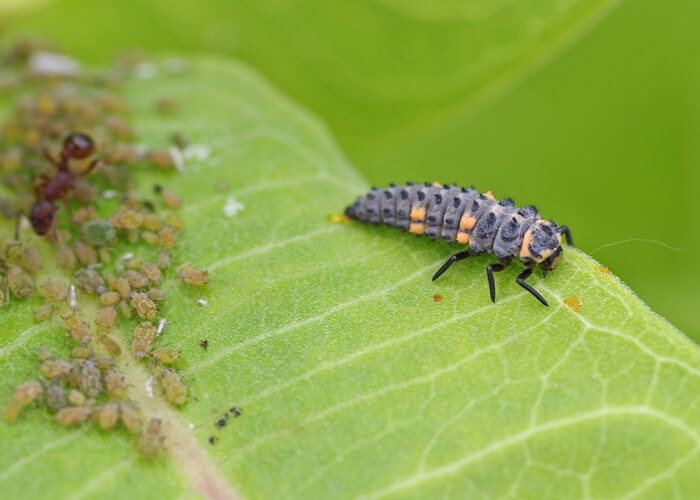
I imagine at one point most gardeners have wondered how to attract ladybugs to their food garden. I know I have. These gorgeous little beetles, with their bright red wings and black spots are stunning, especially when they land on a bright yellow squash blossom. I could be wrong, but I’m guessing ladybugs are the most popular bugs around.
The ladybug is the state insect of seven U.S. states. (It’s tied with the Monarch butterfly as the second most-occurring state insect. The European honeybee is the winner with 14 states.) You can find ladybug umbrellas, stuffed animals, children’s books, metal ladybug garden decor, costumes, coffee mugs, welcome mats, and there’s even a 1992 movie called “Ladybugs.”
Of course, when it comes to the garden, we’re looking for more than just something cute. Deer are cute. Skunks are cute. Rabbits are cute. They also eat your strawberries, your dill, your cucumbers, and almost anything else they can get to. So what’s special about the ladybug and why do we want to know how to attract ladybugs to the garden?
Discover 7 top tips for growing, harvesting, and enjoying tomatoes from your home garden—when you access the FREE guide The Best Way to Grow Tomatoes, right now!

Image courtesy of University of Wisconsin-Milwaukee.
Sure, the ladybug is cute—unless you’re an aphid.
Ladybugs, also known as lady beetles or ladybird beetles, are seemingly harmless insects. They don’t eat our tomato leaves, nor do they chew through the stems of our peas. In fact, they are harmless to humans. It’s a different story for aphids and other soft-bodied pests. Ladybugs primarily feast on aphids, though mites, whiteflies, mealybugs, and scale are on the menu, too.
Worldwide, there are an estimated 5,000 species of ladybugs, and here in North America, we have around 450 species. So even though the “typical” ladybug is red with black spots, you may also see orange, yellow, or black ladybugs. The larvae, which also feed on aphids, have been described as “alligator-like,” due to their elongated and “bristly” appearance.
Both the larvae and the adult beetles are highly mobile, and will relocate to find food. Depending on the species, ladybugs will consume 50 or more aphids in a day, and somewhere around 5,000 aphids in their lifetime.

How to attract ladybugs
A food garden relies heavily on pollinators like bees and butterflies. Lucky for us, if you’re working on attracting these helpers to your garden, you already know how to attract ladybugs.
Ladybugs, like bees, love native flowers and plants. Flowering herbs such as dill, cilantro, and mint attract ladybugs, as do sunflowers and alyssum. Other flowers, such as marigolds and nasturtiums (delicious in salads, by the way!) attract aphids, which keeps them away from your food crops, and means your ladybugs have a food source.
Additionally, do your best to eliminate pesticides. While pesticides can be effective in ridding your garden of pests, they also kill off predator and pollinator insects, such as bees and ladybugs. Plus, a healthy garden that takes advantage of companion planting, good soil practices, and native vegetation can easily withstand most pests.
If you’re feeling particularly ambitious or crafty, you could also build a pollinator hotel! And if it’s hot and dry, it can be helpful to ensure your ladybugs (as well as bees and birds), have some water.
It’s really that easy.
A note on buying ladybugs
As tempting as it may be, buying ladybugs is not ideal. Here’s what the Oregon State University Extension Service has to say about mail-ordered ladybugs:
“Lady beetles or ladybugs are collected from wild populations,” explained [Jack] DeAngelis, entomologist with the OSU Extension Service. “Commercial collectors may inadvertently destroy natural habitat while gathering these creatures. Off-road vehicles are sometimes used to get to ladybug collecting sites that are generally in otherwise pristine areas. And in the process of collecting, packing, storage and release, many beetles are so injured they are no longer effective predators. Many are killed as well.”
They also point out that these ladybugs may not stay in your garden, anyway. They have preferred habitats and food sources just like most other creatures do.
Focus on a healthy, diverse garden and the ladybugs will come.
Have you done anything specifically to attract ladybugs? Did it work?
Note: Food Gardening Network contains links to affiliate websites, including Amazon and Rakuten Affiliate Network, and we may receive a commission for any eligible purchases made by you through links on this page. Any reviews are based on honest reviews of the products.
Discover 7 top tips for growing, harvesting, and enjoying tomatoes from your home garden—when you access the FREE guide The Best Way to Grow Tomatoes, right now!





Your ladybug looks like the Asian Ladybug which is harmful. The good ladybug has 7 black spots.